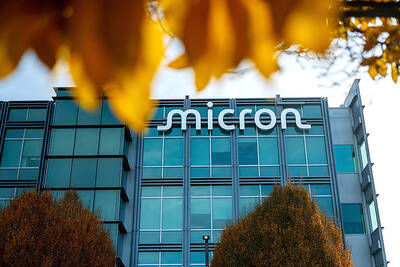Becca Ziegler is only 24, but she already has her death planned out: Her corpse would be deep-frozen to minus-200°C with liquid nitrogen. Ziegler, a US tech firm worker based in Berlin, has signed up with Tomorrow Biostasis, a start-up in the German capital that offers to cryogenically freeze a person’s body after they die.
When the time comes, a team of medics would pump her full of a chemical solution to stop ice crystals from forming in her body and then transport her mortal remains to a storage facility in Switzerland.
The hope is that one day, medical technology might be advanced enough to bring her back to life. Many experts dismiss this gamble on the future as far-fetched, but Ziegler has decided to give it a shot.

Photo: Tomorrow Biostastis, via AFP
“I’m kind of curious to see what the future would be like and, in general, I like life,” said the Californian, who works in educational technology.
“So, if I could buy myself more time, that sounds really appealing,” she said.
Once a fringe pursuit reserved for eccentric billionaires, cryogenic freezing — also known as cryonics — has become more accessible over the past years.
Several companies offering cryopreservation have sprung up in the US and elsewhere, with about 500 people worldwide thought to have been frozen so far.
A persistent myth has it that Walt Disney, the creator of Mickey Mouse, is one of them, but this has been debunked, with BBC reporting in 2019 there is “zero evidence” for this.
Tomorrow Biostasis, founded in 2020, is thought to be the first such company offering the service in Europe. It offers to freeze your body after you die and store it for a membership fee of 50 euros (US$53) a month.
A lump-sum payment of 200,000 euros — or 75,000 euros if you opt to have just your brain frozen — is also due at the time of death, a cost that can be covered by a life insurance payout.
“One of the main goals of this company is to bring the cost down ... so that cryopreservation becomes available to whoever chooses to do it,” Tomorrow Biostasis cofounder Emil Kendziorra said.
Kendziorra, 38, from the western German city of Darmstadt, studied medicine and originally worked in cancer research, but said he became frustrated with the slow pace of developments in the field.
“The one big advantage of cryopreservation is that it is something that you can do right now,” he said.
When a client dies, Tomorrow Biostasis promises to dispatch a specially equipped ambulance and a medical team that starts cooling the body using ice and water as soon as possible.
The body is then infused with a “cryoprotectant” and transported to the facility in Switzerland where it is stored in a pod surrounded by liquid nitrogen and cooled to about minus-200°C.
Tomorrow Biostasis said it has about 700 paying members, and by the end of last year had cryopreserved four people.
The typical customer is aged 30 to 40, healthy, works in technology and is more likely to be male than female, Kendziorra said.
No one has ever been brought back to life after being cryopreserved, but proponents say recent advances in technology have made the prospect more plausible.
In an experiment almost a decade ago, scientists said they were able to cryopreserve the brain of a rabbit and recover it in near-perfect condition.
This year, researchers at China’s Fudan University reported using a new technique to freeze human brain tissue so that it regained normal function after thawing.
Nonetheless, some scientists voice deep skepticism about the bet on a future return to life.
Bringing a person back to life is still a remote prospect, said Holger Reinsch, head of the Cryo Competence Center at the ILK Dresden research institute for refrigeration technologies.
“We are rather critical of the concept of cryonics... I personally would advise you against such an endeavor,” he said. “The magic limit for the life-sustaining cryopreservation of tissue structures is a frog’s heart the size of a fingernail, and this has not changed since the 1970s.”
Even Kendziorra admitted that there are no guarantees.
“I think there’s a good chance for it, but do I know for sure? Absolutely not,” he said.
However, whatever happens in the future, Ziegler is confident she would not regret her decision.
“In some ways it’s weird,” she said. “But on the other hand, the alternative is to be put in a box in the ground and get eaten by worms.”

Micron Memory Taiwan Co (台灣美光), a subsidiary of US memorychip maker Micron Technology Inc, has been granted a NT$4.7 billion (US$149.5 million) subsidy under the Ministry of Economic Affairs A+ Corporate Innovation and R&D Enhancement program, the ministry said yesterday. The US memorychip maker’s program aims to back the development of high-performance and high-bandwidth memory chips with a total budget of NT$11.75 billion, the ministry said. Aside from the government funding, Micron is to inject the remaining investment of NT$7.06 billion as the company applied to participate the government’s Global Innovation Partnership Program to deepen technology cooperation, a ministry official told the

Taiwan Semiconductor Manufacturing Co (TSMC, 台積電), the world’s leading advanced chipmaker, officially began volume production of its 2-nanometer chips in the fourth quarter of this year, according to a recent update on the company’s Web site. The low-key announcement confirms that TSMC, the go-to chipmaker for artificial intelligence (AI) hardware providers Nvidia Corp and iPhone maker Apple Inc, met its original roadmap for the next-generation technology. Production is currently centered at Fab 22 in Kaohsiung, utilizing the company’s first-generation nanosheet transistor technology. The new architecture achieves “full-node strides in performance and power consumption,” TSMC said. The company described the 2nm process as

POTENTIAL demand: Tesla’s chance of reclaiming its leadership in EVs seems uncertain, but breakthrough in full self-driving could help boost sales, an analyst said Chinese auto giant BYD Co (比亞迪) is poised to surpass Tesla Inc as the world’s biggest electric vehicle (EV) company in annual sales. The two groups are expected to soon publish their final figures for this year, and based on sales data so far this year, there is almost no chance the US company led by CEO Elon Musk would retain its leadership position. As of the end of last month, BYD, which also produces hybrid vehicles, had sold 2.07 million EVs. Tesla, for its part, had sold 1.22 million by the end of September. Tesla’s September figures included a one-time boost in

Shares in Taiwan closed at a new high yesterday, the first trading day of the new year, as contract chipmaker Taiwan Semiconductor Manufacturing Co (TSMC, 台積電) continued to break records amid an artificial intelligence (AI) boom, dealers said. The TAIEX closed up 386.21 points, or 1.33 percent, at 29,349.81, with turnover totaling NT$648.844 billion (US$20.65 billion). “Judging from a stronger Taiwan dollar against the US dollar, I think foreign institutional investors returned from the holidays and brought funds into the local market,” Concord Securities Co (康和證券) analyst Kerry Huang (黃志祺) said. “Foreign investors just rebuilt their positions with TSMC as their top target,